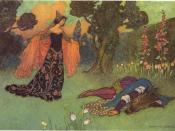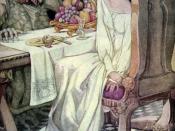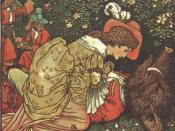Carolyn Kennedy
Dalby
Paper 1
WR 100
9/26/14
In Cross-Cultural Connections by Jack Zipes, Zipes argues that fairy tales follow a utopian quest. Zipes explains that fairy tales start with a sad beginning, have some sort of magical intervention in the middle, and then end happily. The tale of "Beauty and the Beast" by Jeanne-Marie Leprince De Beaumont follows Zipes utopian quest by obeying this pattern. Zipes states "People have always wanted to improve and/or change their personal status" (Cross-Cultural Connections, 845) Beauty is a prime example of a fairy tale character on a persistent "quest for an existence without oppression and constraints." (Cross-Cultural Connections, 845) Beauty is able to find a life without oppression because she lives by the good moral values set for women during this time period. The story of "Beauty and the Beast," like many French fairy tales, was written to teach women in eighteenth century France proper etiquette.
However the story also has an underlying message for everyone; De Beaumont directs her reader to the conclusion that everyone should follow good moral values because in the end good is always rewarded while evil is punished. Jack Zipes claims that everyone is able to benefit from the good moral values taught in fairy tales and De Beaumont's shows this is true through "Beauty and the Beast."
As previously stated, Zipes utopian quest claims fairy tales have a sad beginning, a magical intervention in the middle of the story, and then end happily for the main heroin. "Beauty and the Beast" is a great example of this because it follows all of the specifications of a utopian fairy tale. The story begins with a wealthy single merchant raising his six children, three boys and three girls, in the city. Unfortunately, the merchant...


